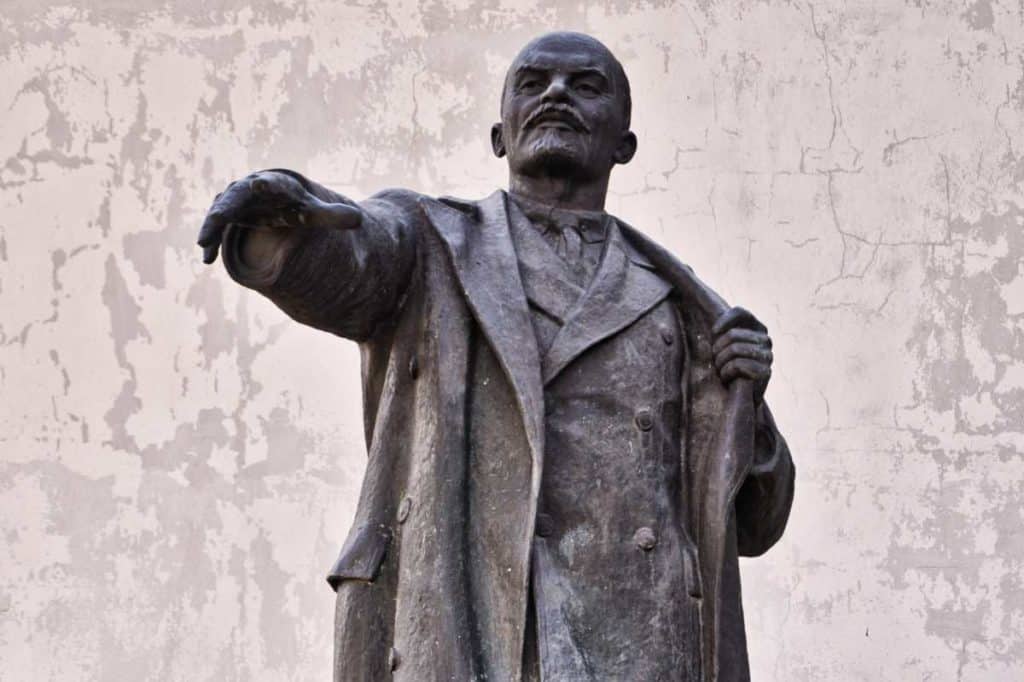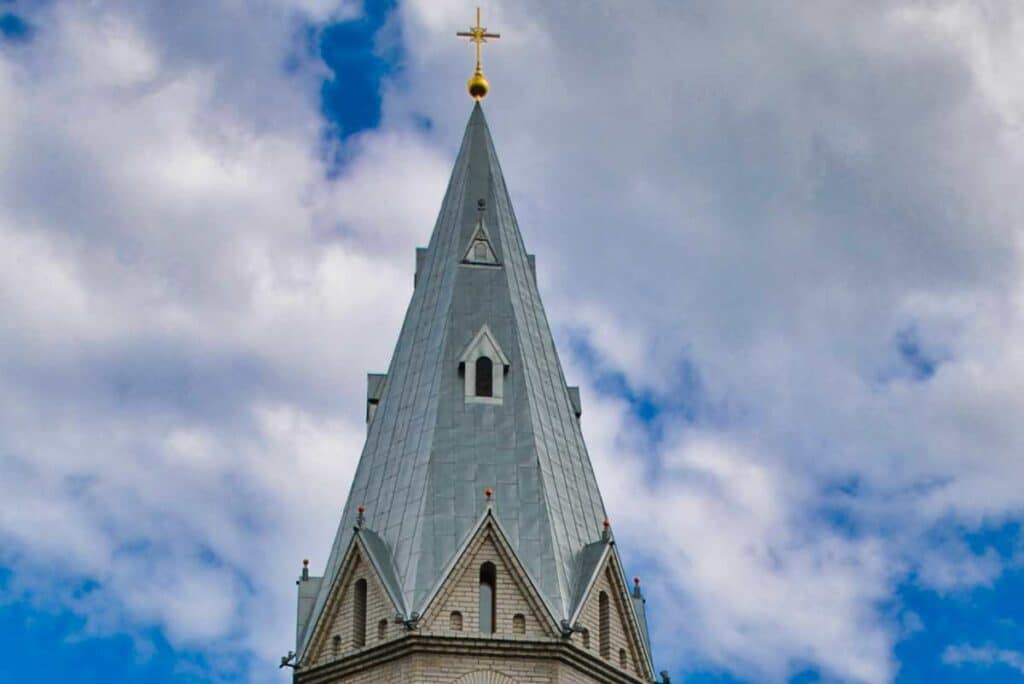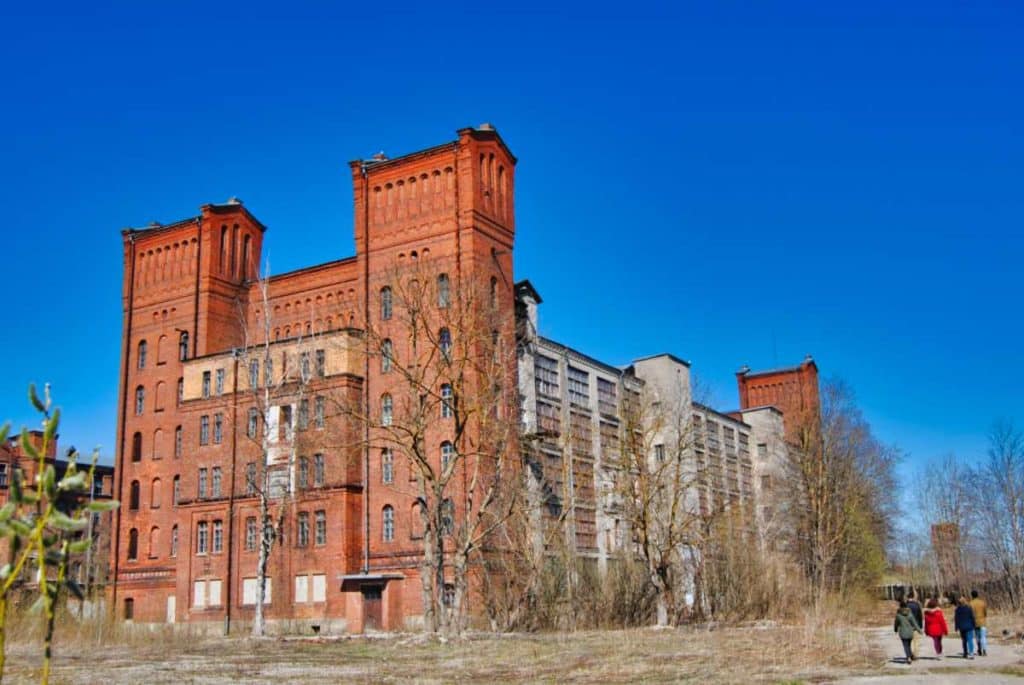Narva is certainly not the most beautiful of all Estonian cities. Located in the far north-east of Estonia, it also lives an existence in the shadow of other places in the country. The city is divided into two parts. The river that gave the city its name and flows into the Baltic Sea north of the city forms the EU’s external border here and divides the Estonian Narva from the much smaller Russian Ivangorod. In this article, we take a closer look at this unusual city and show you what life is like today in the third largest Estonian city (approx. 55,000 inhabitants) with its 95 percent Russian-speaking population. And if you’re interested in the north-east of Estonia in general, just click here.

The troubled history of Narva
Narva has a long and eventful history. There is even a separate culture named after Narva: In the Neolithic period, this culture spread throughout the present-day states of Estonia, Latvia, Lithuania and the area around Kaliningrad. Characteristic of this culture, about which little is otherwise known, were its ceramic works, which today are the only evidence of that time.
Danes, Germans, Swedes and Russians
The conditions for the positive economic development of Narva were ideal, as the town was set back from Narva Bay and protected by the river of the same name, making it an ideal trading post for traders transporting furs from what is now Russia to the west. After Narva had long been under Danish control, the Danes sold the town to the Teutonic Order in the 14th century. At that time, the Hermann’s Fortress, Narva’s most important sight, was already standing.
And just like back then, the river still separates two settlements today. The area to the east of the river was under Russian control and the Grand Duke of Moscow Ivan III had another fortress built there. He gave it the name Ivangorod (“City of Ivan”), which is still the name of the city on the other side of the river today. In the 16th century, Russia was then able to occupy Narva and the cities were united for the first time before the Swedes, Russia’s great antagonist at the time, took control. However, this back and forth did not only have disadvantages for Narva, as this town, which was always located on the border, flourished economically.

A battle with far-reaching consequences
In 1700, two huge Russian and Swedish armies faced each other at Narva. Tsar Peter the Great was determined to capture Narva and the important trading post, but failed and, according to estimates, suffered up to 10,000 casualties and prisoners, including ten generals. The battle was of historical significance, as Peter the Great learned the right lessons from it and used it as an opportunity to introduce important reforms and reorganize the military. Just a few years later, the troops of the two adversaries Charles XII and Peter the Great faced each other in Poltava in what is now Ukraine, and Russia won a victory that finally made it a major European power. This would probably not have been possible without the Battle of Narva.
Narva under Russian rule
In the course of the war against Sweden, Russia got controll of large parts of the Baltic region. However, the city subsequently lost importance, and other port cities in the area experienced an upswing instead. After the brief episode of Estonian independence in the interwar period, the city was occupied by the Soviets in 1940 and almost completely destroyed during World War II. After the war, Narva was settled by many Russians from other parts of the giant empire, who soon became the majority of the population. Today there is little evidence of the former splendor of the city, rather numerous more or less boring apartment blocks were built.

Narva today
After Estonian independence in 1991, Narva was suddenly no longer just a provincial town in a huge empire, but the third largest city in Estonia after Tallinn and Tartu. Compared to the Estonian capital and the student city in the south, Narva today is characterized above all by its tangible Soviet heritage, which is not only noticeable in the many prefabricated buildings, but also in the fact that the overwhelming majority in the city speaks Russian.
Many of them do not have Estonian citizenship today, as this is linked to Estonian language skills and a constitutional test that is required to obtain it. Most of these people are viewed with great suspicion in right-wing Estonian circles, as they are seen as descendants of the much-hated occupiers. Many of them have been issued so-called stateless passports, so in a sense they are people with a homeland but without a proper passport and with limited civil rights. That sounds a bit depressing, but on the other hand, a very special breed of people has developed in north-eastern Estonia and Estonians and Russians now live together quite well. Also most of the young people do speak Estonian and mix both cultures.

Hermann Castle
But even if the prefabricated buildings characterize the city, there are also many sights in the city. The most important is the so-called Hermannsfeste.
The most impressive of these is the 50-metre-high tower known as the Long Hermann, from which you have an impressive view over the city and Ivangorod. It also houses an exciting museum. In the inner courtyard of the fortress, workshops are also held during the warmer months, where traditional craft techniques are presented.

The Lenin that disappeared
There used to be statues of Lenin in every Soviet city. They are considered a symbol of Soviet power, which is why they are usually hated by the oppressed and occupied peoples. With the exception of Russia, most of the successor states to the Soviet Union have therefore now largely disposed of them – even the Lenin statue in Narva was dismantled and removed after the start of the full-scale Russian invasion of Ukraine. This article was written before, but we didn’t want to remove the paragraph.
The Narva Lenin was designed by Estonian artist Olva Männi in 1957 and originally stood in Narva’s central square. The statue remained there until 1993. When a crowd wanted to remove this Lenin as well, the mayor stood up to them and claimed that Lenin was loved here. Only his successor wanted to get rid of him. However, due to the large Russian proportion of the city’s population and out of concern for peace in the city, he did not have the statue destroyed, but only relocated. And so Lenin initially rested in the museum in the Hermannsfeste, which is of course somewhat ironic. After all, it was built to protect the city from Russian invaders. In December 2022, however, it was finally dismantled and is to be exhibited in the History Museum in Tallinn.

Waterfront
No matter whether you are in Ivangorod or Narva on the banks of the Narva River: The panorama with the other fortress is impressive every time. To better enjoy this view and generally increase the recreational value of the city, Narva has a nice waterfront promenade where you can walk, bike, play chess, or – if you feel like it – also work out your body in a fitness park with the best view. Besides, there are some works of art to see and you can relax in one of the pubs.

Ressurection Cathedral
The Cathedral of the Resurrection is the most important Orthodox church in the city. It was built at the same time as the Protestant Alexander Church (see below) and is the only building of its kind in Estonia in the Neo-Byzantine style. This is also the reason why it stands out architecturally in relation to other Orthodox churches in these parts and could easily be found in this form in Greece or Bulgaria. The textile entrepreneur Kreenholm, who also supported the construction of the Alexander Church, was primarily responsible for the financing. We will find out more about this visionary entrepreneur later.

Alexander Church
In addition to the Long Hermann, the Alexander Church is the main landmark of Narva. It was built between 1881 and 1884 and was the largest church in Estonia at the time. From an architectural point of view, it is one of the most unusual churches in the country, as it incorporates medieval forms while at the same time setting modern accents for the time with its jagged design. It was designed by the German architect Otto Pius Hippius from St. Petersburg, and was intended to serve as a place of worship for the Protestant population. After the assassination of Tsar Alexander II, it was given his name. After the Soviets destroyed the church during a bombardment in 1944, it was only rebuilt after independence.

Lion Monument
A little to the south of the castle, high on a pedestal, stands a monument to a majestic lion guarding something that looks a bit like a soccer with its paw (but it is more likely a globe with a royal crown, intended to emphasize the Swedes’ claim to power). In fact, it is a gift from the Swedish king to the city from the year 2000, commemorating the 300th anniversary of the battle between the Russians and the Swedes. It is an exact copy of a statue in front of the Royal Palace in Stockholm. Another reason why the Lion of Narva is so popular is that you have an excellent view of both fortresses from here.

Old city hall
In the mid-17th century, Georg Teuffel, a master builder from Lübeck who had previously worked in the Baltic region, set out for the far north and built this Baroque gem right in the center of Narva. This was once the busiest part of the city, but in 1944 it was almost razed to the ground. As one of the few historical buildings, the Soviets had the Old Town Hall rebuilt. Unfortunately, the building has been empty since the fall of communism and is not in good condition. Inexplicably, since it is one of the few baroque testimonies in this part of Estonia.

Narva College
There seemed to be no money for the Old Town Hall, but in 2012 the square was given a rather bizarre building, which today serves as the conference center of the Narva College of the University of Tartu. The pseudo-classical facade is an eye-catcher in itself. However, the building is literally crowned by a futuristic roof structure that seems to grow into the sky at a rather oblique angle. Conferences are held here today, but you can also relax in the very nice Kohvik Muna inside the college (see below).

Kreenholm river island
Now we leave the center of Narva and explore the surroundings of the city. Kreenholm or Kränholm, as it is known in German, is the name of an island in the Narva River south of the city center. It is located entirely on the Estonian side and was already being used commercially in the 14th century. After several mills stood here, the first spinning mills developed. From these, the Kreenholmi Manufaktuur emerged in the 19th century around the Bremen entrepreneur Ludwig Knoop. It developed into one of the largest textile factories in the world and experienced its heyday before the First World War. Today you can find out more about the huge brick complex and its history on a guided tour.

War Cemetery
As early as 1943, the Wehrmacht established a cemetery for dead German soldiers north of the center on the Narva-Jõesuu road. This cemetery was extended in the course of time and today it is the central burial place of German soldiers of the Narva front. About 10,000 fallen soldiers found their final resting place here. A memorial square with a 4.50 m high natural stone cross commemorates the horrors of the Second World War and this place.

Narva-Jõesuu
Hungerburg (“Castle of hunger”) is the not exactly flattering German name for the most northeastern of all Estonian towns. Narva-Jõesuu borders directly on Russia – and on the Baltic Sea. For a long time, Narva-Jõesuu with its long sandy beach was known mainly as a health resort, as evidenced by the many, partly dilapidated spa hotels and wooden houses from the 19th century. They were joined in Soviet times by several modern sanatoriums and rest homes. It is precisely this mixture of Soviet and Tsarist-era buildings in combination with the sea and the beach that makes this unusual place so appealing. Recently, Narva-Jõesuu, which had long suffered from the absence of Russian spa guests, has recovered and is slowly awakening from its long slumber.

Ivangorod – Russia has moved even further away
Ivangorod, or Jaanilinn, as the town is called in Estonian, has a population of just under 10,000, is much smaller than Narva and has developed much less positively than Narva in Estonia since the fall of communism. It is the last western tip of Russia and those looking for work are more likely to move to St. Petersburg, 150 kilometers away, or migrate to Estonia or the West. By the way, in contrast to today, Ivangorod was part of Estonia in the interwar period, and its external border ran only behind the city. The Soviet invasion in 1940, however, ended this short chapter, with Estonian Interior Minister Mart Helme reaffirming Estonian claims to the city in 2019.
As Ivangorod is part of the Russian border area, residents from other parts of Russia must obtain a permit before visiting in order to be allowed to travel here. And since Western tourists also need a visa and applying for one is hardly worthwhile for the visit, it usually remains just a view of the picturesque fortress on the Narva River, which separates the EU from Russia. After the start of the Russian full-scale invasion of Ukraine, both sides have been deploying propaganda here, which is clearly visible on the riverbank promenade.
Eating and drinking in Narva – these are our recommendations
- Kohvik Muna, Raekoja plats 2. “One day we’ll all meet here” is the motto of this café, which is housed in the college. Quite possibly, because the delicious international dishes will make your mouth water.
- Old Trafford, Peetri plats 1. Although the restaurant is named after Manchester United’s stadium, it has nothing to do with English cuisine. Instead, fans of Russian home cooking and international meat dishes get their money’s worth here in a chic atmosphere.
- Dve Sestri: Here you can eat real home cooking. The homemade solyanka is particularly recommended.
Accomodation in Narva Estonia
- Narva Hotell*, Puskini 6 Very central, clean hotel with rooms in different categories.
- Narva-Jõesuu Spa*, Aia 3, Narva-Jõesuu. There’s no better way to relax: A beautiful hotel from the 1930s in a functionalist style that not only takes you on a journey back in time, but also offers all the modern comforts you would expect from a spa hotel.
Book and movie tips
Have you become curious and want to get to know Estonia better? Then pick up the travel guide “Baltic States”, which my colleague Thorsten Altheide has published together with other experts at Reise Know-How Verlag. Here you will not only find lots of information about Estonia, but also about Lithuania and Latvia.
No products found.
Historical novel by Estonian author Jaan Kross, which describes a love story in Narva.
No products found.
In this book, travel journalist Stefanie Bisping describes Estonia in a very personal way and paints a coherent picture of the country and its people with many interesting background stories.
No products found.
In this book, Estonian-born Finnish author Ilmar Taska takes an unconventional look at the post-war period in Estonia.
No products found.
Wonderful documentary that introduces Estonia and all its natural beauty.
No products found.
We hope you enjoyed our trip to Narva. What is your favorite place for a trip to Estonia? Let us know and write us a comment!



